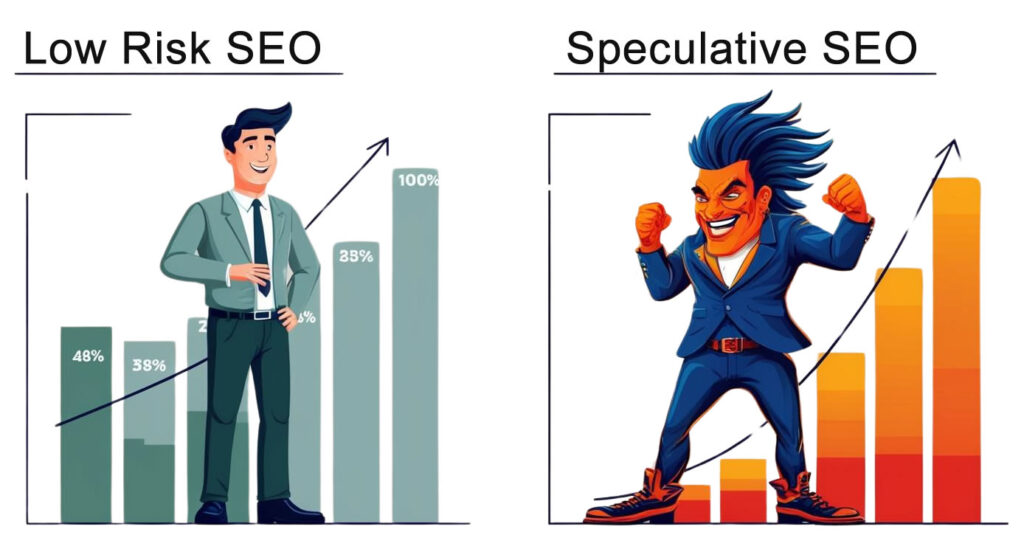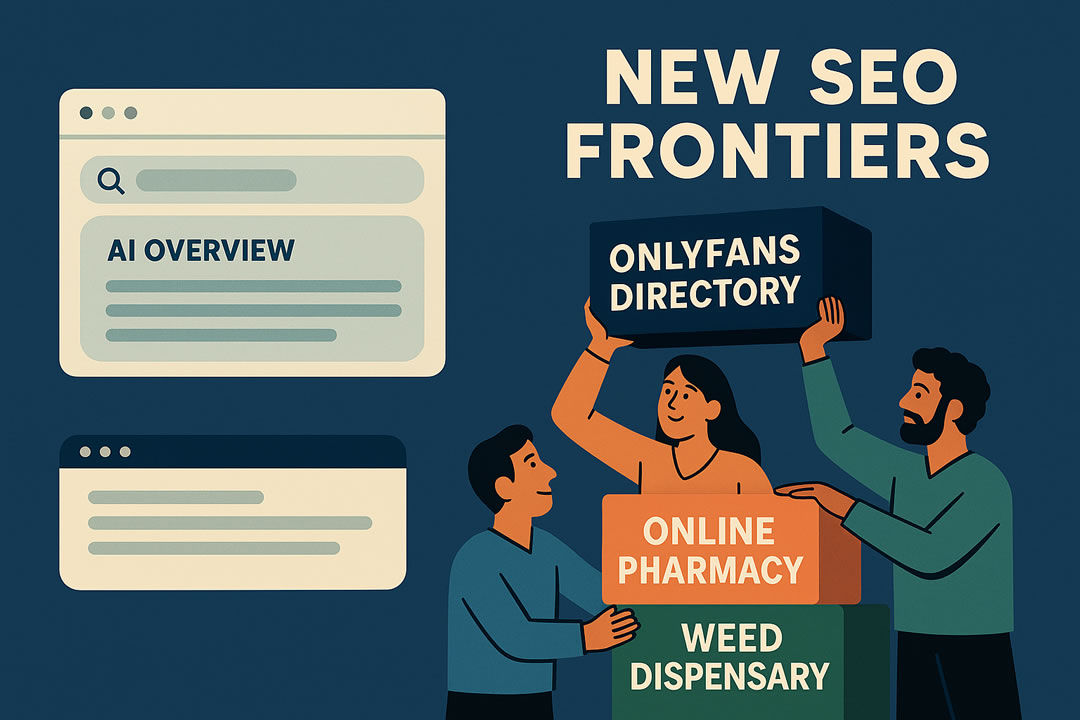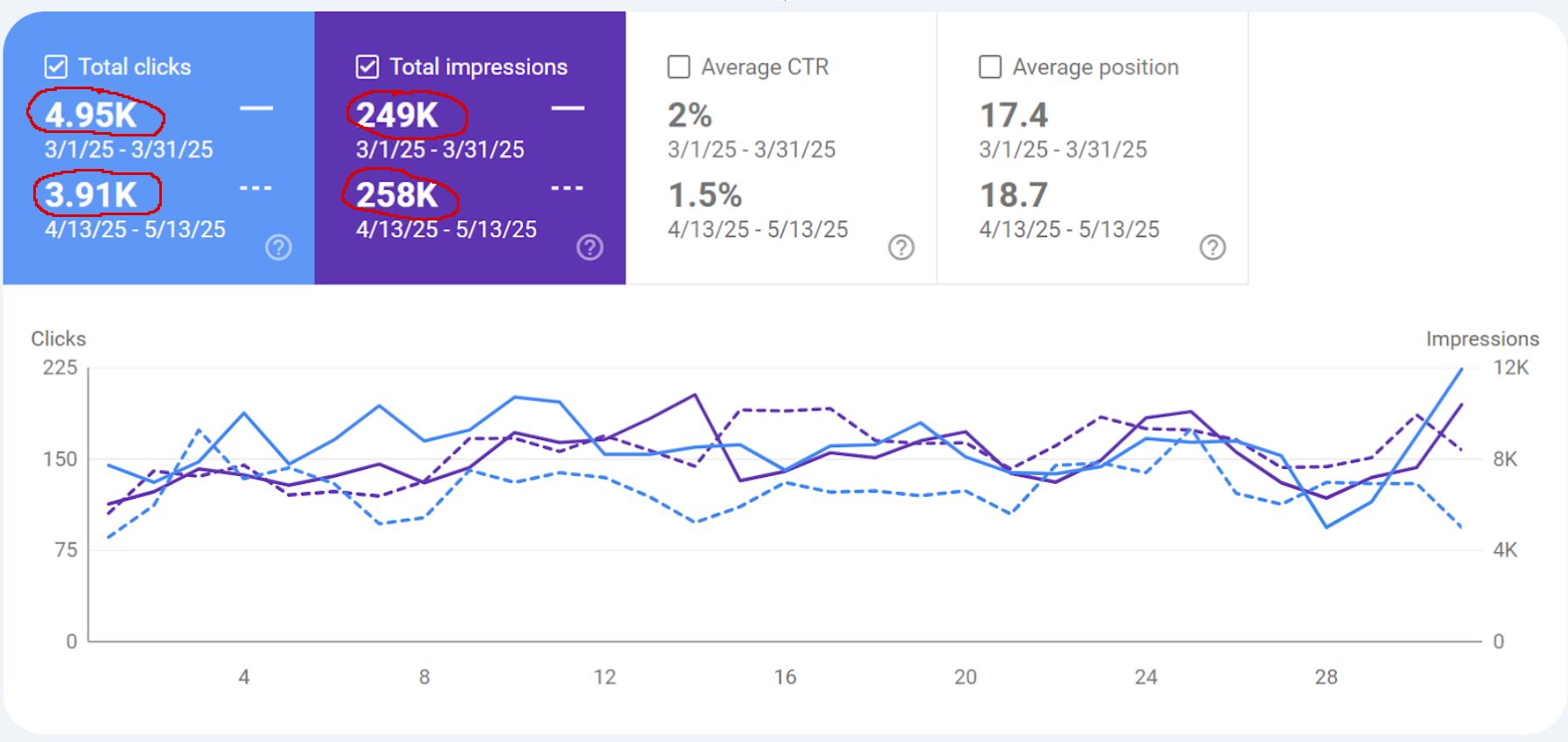
At LinkJuiced we have clients with different levels of risk aversion. Some are very conservative, investor-financed startups that want rapid but predictable and secure growth. Others are happy to spin out 10 sites in 10 different niches, with different levels of risk-taking when it comes to SEO.

Now, we don’t do anything black hat—no cloaking, no link buying. That is not speculative SEO; that’s crazy town SEO, where you build websites and execute a black hat strategy with the hope of making a profit before the inevitable Google hammer drops.
We don’t do this type of SEO.
But with the advent of AI and its power to scale content, we have executed some SEO strategies where the client was willing to take a risk and wanted to see how fast they could build massive website rankings. In the last 5 months, one such project took us and the client on a white-knuckle ride.
The website niche
We are not at liberty to say, as there are not too many sites in this niche. What I can say is it’s:-
- A business directory.
- In a niche with massive, highly valuable traffic.
- Not gambling-related.
- There are no Adwords allowed in this niche, thus organic rankings are incredibly valuable.
The Strategy
We built a Python scraper that would scrape the internet for all listings in this niche. Listings are location and tag-sensitive, but whilst locations are often easy to determine, they are not tagged. We used AI to:-
- Create relevant tags for each listing.
- Create a detailed page for each listing based on all the data we could find about this business on the net. We amalgamated reviews, service details etc
- We created a short AI description of each business (2 sentences) that was published on the category and tag pages.
Then, we launched V1 of the website.
V1 did very well for about 3 months, but then in March 2024 traffic cratered. The site which had grown to 1500 visitors per day was now at 15 per day. We hypothesised what might have caused the problem and checked for other sites that had recently had their rankings demolished. We discovered.
- Many sites with detail pages entirely created by AI have been similarly crushed.
- Many sites with detail pages, where the visitor would probably want to go straight to the business’s website rather than a detail page, have been crushed.
Our client’s details were both 100% AI and also probably an unnecessary step for users. It was not going to work.
Hard Talk with the Client
The client’s initial plan was to not only rank for combinations of TAG + LOCATION – they also wanted to rank for BUSINESS NAME. Other websites in this niche were achieving this, and there was a lot of potential traffic and revenue to be gained from such rankings. But…. now we had a problem. ALL websites trying to rank for BUSINESS NAME in this niche had been crushed.
Perhaps because they were also AI-created, perhaps because Google had decided users were not interested in this intermediate step before visiting the final destination website…. but it didn’t matter. One or both of these reasons was true.
We had no way to make the pages without using AI, and no way to change that people didn’t want to take this intermediate step.
The plan needed to change and the new plan meant giving up on ranking for the business detail pages.

Recovery Strategy 1
We trashed the domain name and launched the fixed site under a new domain. The existing domain was only a few months old and had few links, and we figured that the Google filter might take months to be lifted, so we were better off starting from scratch. We didn’t even redirect the old to the new in case the filter followed.
We trashed the detail pages. No site had survived with AI-created detail pages. Google seemed very clear that this was not negotiable, so we killed them. Instead, the category and tag pages with the listings took users straight to the listing/business webpage of the listing owners.
We didn’t remove the one or two-sentence AI-generated listing descriptions from the category and tags pages. We believed these made the pages so objectively more useful that Google would allow this, even though we were still technically creating scaled content pages. The main chart exported from Google Search Console shows the results. The site immediately gained good traction in Google, ranking for many valuable location and tag keywords. For two weeks, things appeared to be on track. Then, disaster struck, and rankings cratered again.
Recovery Strategy 2
We knew Google’s main issue with the site was scaled content, which Google was closely aligning with scaled AI content. Though accurate and valuable, the short AI descriptions seemed to be tripping Google’s “You shall not pass with scaled AI content” filter. There was nothing to be done other than to delete this content.
It was a painful but necessary decision. Removing the AI content made the pages objectively less helpful. We had never seen this in our combined 30 years of SEO experience: unique, helpful content causing a downgrading in rankings. We would have to make the site less useful to regain rankings. It was in total opposition to Google’s principles of making your site the best.
Our take on this is.
- Google has determined that scaled content, even if incredibly useful, is a critical business risk. It’s too easy to spin out websites this way. Websites that Google would need to index, crawl, and store data for. Google would need to massively upscale its infrastructure to manage this flood of content with no real financial upside.
- Google perhaps wants to keep the right to show AI-generated content in search results.
Whatever the reason… the AI content had to go. Google can clearly tell the content is unedited AI content. And don’t fool yourself into thinking Google is fooled by AI normalizing tools. It’s not. A company with the resources of Google can easily reverse engineer these to see if it’s still just AI content.
We deleted the AI descriptions and replaced them with tags. And then we waited.
Improved UX + No Scaled AI content = Success
This fix was applied on March 20th, and on March 29th, rankings came screaming back, way higher than before. We were no longer receiving the scaled content filter or the bad UX filter. Even though the changes meant we had far less rich content on the category and tag pages, traffic was doubled from before the second filter was applied.
It appears we have filled the hole left by all the other sites similarly smashed by this ‘No Scaled AI Content’ filter.
Our client is delighted, of course. The initial strategy was based on doing what we could see was working for other sites… but we always knew that there was risk involved. We salvaged things quickly, but the recovery speed was not just luck or chance.
How a Potential Disaster was Averted
- We and the client were aware of the risk from the start. We knew we might have to pivot quickly and were ready to do so if necessary.
- When things went wrong we got busy fast. We quickly analyzed the common factors in other sites that had similarly been affected, determined the problems, and fixed them.
- Our engineering team is excellent, large, and fast. We redesigned and programmed the site in 4 days. Meanwhile, we built a new Python + AI tagging system to do better tagging to replace the descriptions. In large orgs, this might have taken months, but we are large enough to quickly do lots of programming, and small enough to be nimble and respond to problems quickly.
Takeaways from This
- What Is OK with Google today might not be tomorrow.
- If you are risk averse, you must have an SEO strategy that assumes that Google WILL tighten the screws on borderline SEO strategies shortly and wholly avoid them. We would never have executed such a strategy for a risk-averse company.
- If you want to push things, that’s fine. But make sure you can afford to lose all traffic for a while, and ensure you have the team to determine the problem and fix it and the budget to do it fast.
Starter
- Minimum 5 links per month
- Includes creation of link bait content
- We handle journalist outreach
- No link Buying. Genuine Press Links
- Suitable for most businesses
Starter
- Minimum 15 links per month
- Includes creation of link bait content
- We handle journalist outreach
- No link Buying. Genuine Press Links
- Suitable for most businesses
Starter
- Minimum 30 links of quality per month
- Involves a Study and international PR
- We handle Journalist Outreach
- No link Buying. Genuine Press Links
- For businesses looking for big, fast results




